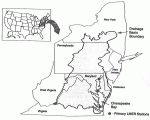Processes of Recycling, Organic Transformation and Exchange between Uplands and the Sea (PROTEUS)
The PROTEUS-LMER is focused on the complex dynamics of nutrient cycling in the Chesapeake Bay--one of the largest estuaries in the world, extending some 314 kilometers (1cm) along a north-south axis and ranging from 6 to 56 km in width. The Bay has a mean depth of 8.5 meters, with a channel ranging from 10-50 meters depth running along its length. Its watershed covers an area of approximately 166,000 1cm2, draining piedmont and coastal plain provinces of three states: Pennsylvania, Maryland and Virginia.
There are approximately 12.7 million people inhabiting the Chesapeake Bay watershed, and most of the major population centers are located on the shores of the estuary and its tributaries. Over 60% of the land in the basin is still forested, while croplands, pastures and urban-residential areas comprise about 20, 10 and 15%, respectively, of the land uses in the watershed.
From 1950 to 1980, human populations in the basin increased by two-thirds; nutrient inputs to the Bay from sewage effluents and agricultural runoff in the watershed nearly doubled. In addition to the long-term trends in annual loadings of nitrogen (N) and phosphorus (P) to the estuary, a relatively large interannual variablity in loadings occurs in relation to fluctuating hydrological factors.
Research Design
The NSF LMER project, which was initiated for Chesapeake Bay in the fall of 1988, has four research components:
- Data collection in the water column (or pelagic) habitat
- Data collection in the sediment (or benthic) habitat
- Observations on physical circulation
- Modeling of physical and ecological processes
Field studies consist of a core program in which seasonal and interannual variations in basic nutrient and related ecological conditions are characterized for the Bay’s three main salinity provinces (oligohaline, mesohaline and polyhaline), and a special focus program in which detailed analyses are concentrated on a particular spatial or temporal dimension of the Bay’s nutrient cycling/organic production system. The overall research program relies heavily on computer-based simulation modeling studies of ecological and physical processes as a means to effectively integrate the diverse components of the research into a unified ecosystems perspective.
Significant correlations between inputs of N and, to a lesser extent of P, and phytoplankton production have been observed for Chesapeake Bay and other estuaries. These data suggest the interesting possibility that production per unit nutrient input is generally greater for Chesapeake Bay than for most other coastal systems. PROTEUS researchers have hypothesized that this feature is related to physical circulation mechanisms which promote nutrient retention and ecological mechanisms which, in turn, effect efficient nutrient recycling. Indeed, indirect evidence indicates that these nutrient retention and recycling mechanisms are operating on seasonal as well as interannual time scales.
Preliminary Results:
Preliminary input-output budgets for N, P, and silicon (Si) in Chesapeake Bay suggest several interesting results. In the case of N, for example, over 80% of the total inputs to the Bay arise from runoff and other diffuse “non-point” sources, while only 12% come from municipal and industrial “point” discharges. Direct precipitation of acid rain onto the Bay surface contributes 5% of the total. Burial in sediments accounts for less than 10% of inputs; 3% of the N inputs are removed from the Bay via fish harvests, thereby emphasizing the direct dependency of fisheries on inputs of new N. Although denitrification results in N losses equivalent to about 50% of the inputs for other estuaries studied in recent years, the process accounts for only 20% of N inputs in Chesapeake Bay. This apparently results from inhibitory effects of seasonal anoxia in this eutrophic ecosystem. Thus, almost 70% of the total N inputs are unaccounted for and, it is hypothesized, exported to the sea at the Bay mouth. Most of the P and Si appear to be similarly exported.
Currently, PROTEUS researchers are using combined hydrographic-ecological models to improve estimates of nutrient export on annual time scales. The large unaccounted-for fraction of nutrient inputs also raises the question of how the Bay ecosystem can be so retentive of and responsive to interannual variations in nutrient inputs from the watershed if most of these nutrient inputs are being exported to the sea.
It is postulated that nutrients entering the estuary from its watershed are retained for a sufficient period to be used, transformed and reused in a sequence of processes which support the system’s rich organic production, before being exported to the sea in relatively refractory (dissolved and particulate organic) forms. The details of these processes, as well as how they are affected by changing rates of nutrient inputs, remain open questions.
For more information contact WM. Kemp, University of Maryland, Horn Point Environmental Laboratories, P.O. Box 775, Cambridge MD 21613; or WR. Boynton, Chesapeake Biological Laboratory, P.O. Box 38, Solomons MD 20688.

 Enlarge this image
Enlarge this image